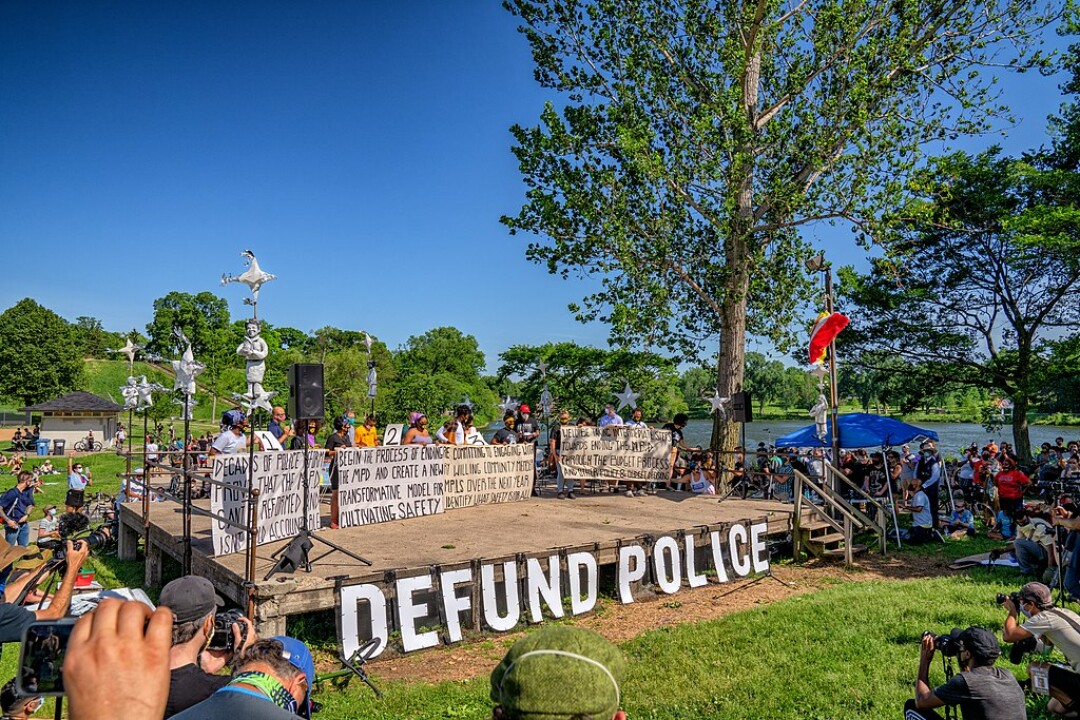Police reform is possible

A supermajority of the Minneapolis City Council committed to de-funding and dismantling the Minneapolis Police Department before a crowd gathered at Powderhorn Park in Minneapolis on June 7. The decision came after peaceful protests and rioting in the wake of the police killing of George Floyd. Photo by Tony Webster.
“We must, as citizens, address head-on the issue of police brutality and sustained injustices against the African American community. We must, as citizens, support and defend the right – indeed, the solemn obligation – to peacefully assemble and to be heard. These are not mutually exclusive pursuits.” Adm. Micheal Mullen, former chairman of the Joint Chiefs of Staff
“We do not need to militarize our response to protests. We need to unite around a common purpose. And it starts by guaranteeing that all of us are equal before the law.” General James Mattis, former Secretary of State.
In last week’s online Reader I said there is no excuse for excessive use of force by police. Most of us know this and know that it must change. Given the failure of past efforts at police reform it would be easy to think this is just another hopeless cause. But there are signs of hope this time around. This time maybe, if people keep up the pressure, real reform may be possible.
I see hope for change coming from all over the country and from some unusual sources.
The number and duration of protests is encouraging. Protests have occurred in many places, including rural areas and cities of all sizes.
Peaceful protests of more than 1,000 marchers have occurred across Wisconsin and multiple places in Minnesota, including Duluth. These have been attended by people of all races and have included elected officials.
This broad participation is particularly dramatic given the pandemic fears. People are angry and are demanding change.
It is encouraging and very unusual to have members of the establishment such as General James Mattis and Admiral Michael Mullen speaking out about police violence and the right – “indeed, the solemn obligation” – to protest. To date four former chairmen of the Joint Chiefs of Staff have condemned Trump for his statement about using the regular military to “dominate” city streets and shut down protests.
It is also encouraging that some police departments are starting to change. Some police departments are no longer sweeping the abuses under the rug. Officers who use excessive force are being disciplined, fired, and prosecuted.
In some places police are showing solidarity with the peaceful protesters.
Minneapolis Police Chief Medaria Arradondo knelt at the street corner memorial for George Floyd.
In Houston, Floyd’s hometown, Police Chief Art Acevedo kneeled along with protesters and spoke about the hope Floyd’s death would spark change.
In New York, Oregon, Iowa, Washington, Washington D.C, Kentucky, and Louisiana officers “took a knee” during demonstrations. Law enforcement leaders in New Jersey, Michigan, and Virginia joined in marches alongside protesters. In Camden County, New Jersey, Police Chief Joe Wysocki joined demonstrators at the head of a march holding a sign that read “Standing in Solidarity.”
In Genesees County, Michigan, Sheriff Chris Swanson walked with demonstrators and later addressed the crowd saying, “What I saw was ...people who are angry, people who feel they don’t have a voice ... all you are asking for is a voice and dignity for all ... we are with you ... ”
This demonstrates there are alternatives to the use of force. It demonstrates that defusing situations is a better strategy than shooting, beating and tear gassing people.
It shows that many police officers are also appalled by what happened to George Floyd and are ready to accept long overdue restrictions on the use of force. Many police officers want to work in a professional environment that is honored and respected by the public.
The good news is we know what needs to be done to fix the problems with policing in this country.
There have been many blue ribbon commissions producing reports with detailed recommendations for community policing, bias free policing, use of force, accountability, and public engagement. The Minnesota Department of Public Safety released one just prior to the killing of George Floyd. I list links to these resources at the end of this article.
Some politicians are responding. Legislation has been introduced in the U.S House of Representatives to reform police practices. In Wisconsin, Gov. Evers is proposing reform legislation. In Minnesota Gov. Walz has spoken forcefully for change. The Department of Human Rights launched a civil rights investigation and and issued an emergency order to require structural changes in the Minneapolis Police Department. The city agreed to:
• Immediately banning the use of choke holds.
• Requiring officers to report and intervene if another officer uses unauthorized force.
• The use of crowd control weapons during protests and demonstrations may only be approved by the chief of police.
• Timely and transparent discipline of police officers for excessive use of force.
• Body camera footage may be audited by the Minneapolis Civil Rights Department.
Of course many police departments are still responding to incidents and protests with more force. They are proving that reform is needed by their actions toward peaceful protesters.
This is the standard response for a society with militarized police practices. It is the traditional American way to deal with trouble makes especially people of color, immigrants, labor organizers, and other social dissidents. This is why reform is needed.
As one report from the Leadership Conference on Human and Civil Rights says, “Police departments can be resistant to change. Indeed, the warrior culture, which emphasizes police as enforcers of law rather than keepers of the peace, is deeply embedded in many police departments. This mindset heightens tension and widens the separation between departments and communities by propagating an “us-versus-them” mentality.”
For change to happen we must change our militarized, warrior culture. We need trust, fairness, justice and mutual respect between police departments and the communities they serve. That requires ending the excessive use of force.
Like so many other problems in this country, we know what is needed. But do we have the political will and public engagement to make it happen?
Working Group Police-involved Deadly Force Encounters, February 2020, Minnesota Dept. of Public Safety
Vision for Justice 2020 and Beyond: A New Paradigm for Public Safety
Campaign Zero
New Era of Public Safety a Guide to Fair, Safe, and Effective Community Policing: The Leadership Conference on Civil and Human Rights
The Final Report of the Presidents Task Force on 21st Century Policing, May 2015
